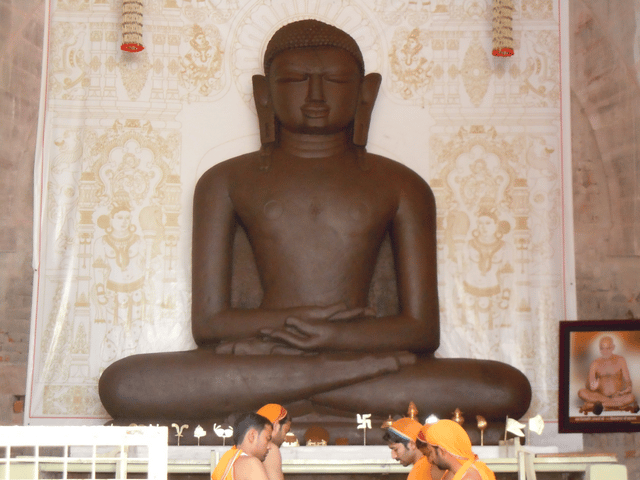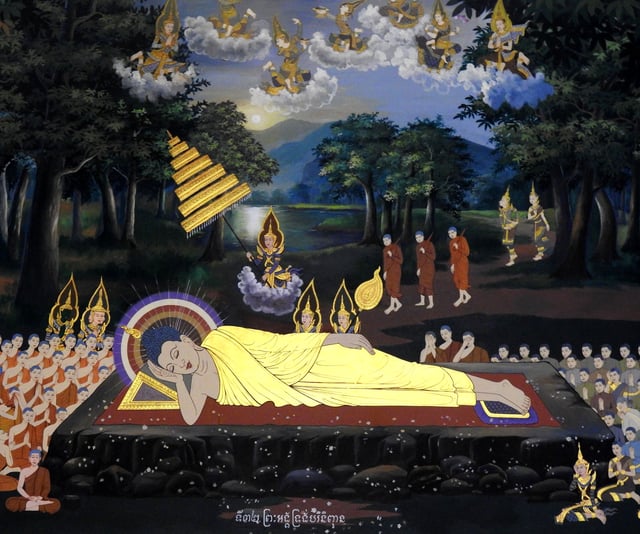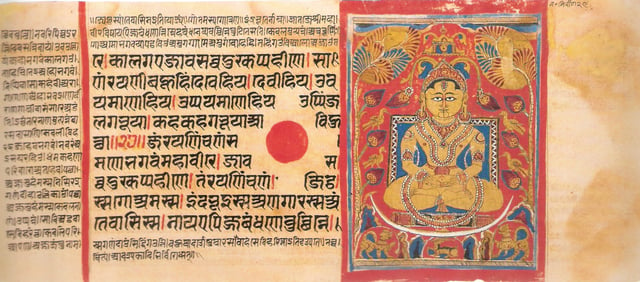Nirvana

Nirvana

| Translations of Nirvana | |
|---|---|
| English | enlightenment, liberation, salvation |
| Pali | निब्बान (nibbāna) |
| Sanskrit | निर्वाण (IAST: nirvāṇa) |
| Burmese | နိဗ္ဗာန် (IPA: [neɪʔbàɴ]) |
| Chinese | 涅槃 (Pinyin: nièpán) |
| Japanese | 涅槃 (rōmaji: nehan) |
| Khmer | និព្វាន (UNGEGN: nippean) |
| Korean | 열반 (RR: yeolban) |
| Mon | နဳဗာန် ([nìppàn]) |
| Mongolian | Нирваан дүр (nirvaan dür) |
| Shan | ၼိၵ်ႈပၢၼ်ႇ ([nik3paan2]) |
| Sinhala | නිර්වාණ (nivana) |
| Tibetan | མྱ་ངན་ལས་འདས་པ། (mya ngan las 'das pa) |
| Thai | นิพพาน (RTGS: nipphan) |
| Vietnamese | niết bàn |
| Indonesian | nirwana |
| Glossary of Buddhism | |
| Translations of Nirvana | |
| English | freedom, liberation |
| Sanskrit | निर्वाण (IAST: nirvāṇa) |
| Bengali | নির্বাণ (nirbanô) |
| Gujarati | નિર્વાણ (nirvāṇa) |
| Hindi | निर्वाण (nirvāṇa) |
| Javanese | ꦤꦶꦂꦮꦤ (nirwana) |
| Kannada | ನಿರ್ವಾಣ (nirvāṇa) |
| Malayalam | നിർവാണം (nirvanam) |
| Nepali | निर्वाण (nirvāṇa) |
| Odia | ନିର୍ବାଣ (nirbaana) |
| Punjabi | ਨਿਰਵਾਣ (niravāṇa) |
| Tamil | வீடுபேறு (Veeduperu) |
| Telugu | నిర్వాణం (nirvaanam) |
| Glossary of Hinduism | |
Nirvāṇa (/nɪərˈvɑːnə/ neer-VAH-nə, /-ˈvænə/ -VAN-ə, /nɜːr-/ nur-;[7] Sanskrit: निर्वाण nirvāṇa [nɪɽʋaːɳɐ]; Pali: निब्बान nibbāna; Prakrit: णिव्वाण ṇivvāṇa, literally "blown out", as in an oil lamp[8]) is commonly associated with Hinduism, Jainism and Buddhism, and represents its ultimate state of soteriological release, the liberation from repeated rebirth in saṃsāra.[9][84][10]
However, Buddhist and non-Buddhist traditions describe these terms for liberation differently.[14] In the Buddhist context, nirvana refers to realization of non-self and emptiness, marking the end of rebirth by stilling the fires that keep the process of rebirth going.[14][15][16] In Hindu philosophy, it is the union of or the realization of the identity of Atman with Brahman, depending on the Hindu tradition.[17][18][19] In Jainism, it is also the soteriological goal, it represents the release of a soul from karmic bondage and samsara.[20]
| Translations of Nirvana | |
|---|---|
| English | enlightenment, liberation, salvation |
| Pali | निब्बान (nibbāna) |
| Sanskrit | निर्वाण (IAST: nirvāṇa) |
| Burmese | နိဗ္ဗာန် (IPA: [neɪʔbàɴ]) |
| Chinese | 涅槃 (Pinyin: nièpán) |
| Japanese | 涅槃 (rōmaji: nehan) |
| Khmer | និព្វាន (UNGEGN: nippean) |
| Korean | 열반 (RR: yeolban) |
| Mon | နဳဗာန် ([nìppàn]) |
| Mongolian | Нирваан дүр (nirvaan dür) |
| Shan | ၼိၵ်ႈပၢၼ်ႇ ([nik3paan2]) |
| Sinhala | නිර්වාණ (nivana) |
| Tibetan | མྱ་ངན་ལས་འདས་པ། (mya ngan las 'das pa) |
| Thai | นิพพาน (RTGS: nipphan) |
| Vietnamese | niết bàn |
| Indonesian | nirwana |
| Glossary of Buddhism | |
| Translations of Nirvana | |
| English | freedom, liberation |
| Sanskrit | निर्वाण (IAST: nirvāṇa) |
| Bengali | নির্বাণ (nirbanô) |
| Gujarati | નિર્વાણ (nirvāṇa) |
| Hindi | निर्वाण (nirvāṇa) |
| Javanese | ꦤꦶꦂꦮꦤ (nirwana) |
| Kannada | ನಿರ್ವಾಣ (nirvāṇa) |
| Malayalam | നിർവാണം (nirvanam) |
| Nepali | निर्वाण (nirvāṇa) |
| Odia | ନିର୍ବାଣ (nirbaana) |
| Punjabi | ਨਿਰਵਾਣ (niravāṇa) |
| Tamil | வீடுபேறு (Veeduperu) |
| Telugu | నిర్వాణం (nirvaanam) |
| Glossary of Hinduism | |
Etymology
The word nirvāṇa, states Steven Collins, is from the verbal root vā "blow" in the form of past participle vāna "blown", prefixed with the preverb nis meaning "out". Hence the original meaning of the word is "blown out, extinguished". Sandhi changes the sounds: the v of vāna causes nis to become nir, and then the r of nir causes retroflexion of the following n: nis+vāna > nirvāṇa.[21]
The term nirvana in the soteriological sense of "blown out, extinguished" state of liberation does not appear in the Vedas nor in the Upanishads. According to Collins, "the Buddhists seem to have been the first to call it nirvana."[22] However, the ideas of spiritual liberation using different terminology, with the concept of soul and Brahman, appears in Vedic texts and Upanishads, such as in verse 4.4.6 of the Brihadaranyaka Upanishad.[23] This may have been deliberate use of words in early Buddhism, suggests Collins, since Atman and Brahman were described in Vedic texts and Upanishads with the imagery of fire, as something good, desirable and liberating.[24]
Origins
Nirvāṇa is a term found in the texts of all major Indian religions – Buddhism,[25] Hinduism,[26] Jainism[27] and Sikhism.[28][29] It refers to the profound peace of mind that is acquired with moksha, liberation from samsara, or release from a state of suffering, after respective spiritual practice or sādhanā.[2]
The idea of moksha is connected to the Vedic culture, where it conveyed a notion of amrtam, "immortality",[33][34] and also a notion of a timeless, "unborn", or "the still point of the turning world of time". It was also its timeless structure, the whole underlying "the spokes of the invariable but incessant wheel of time".[3] The hope for life after death started with notions of going to the worlds of the Fathers or Ancestors and/or the world of the Gods or Heaven.[33][4]
The earliest Vedic texts incorporate the concept of life, followed by an afterlife in heaven and hell based on cumulative virtues (merit) or vices (demerit).[35] However, the ancient Vedic Rishis challenged this idea of afterlife as simplistic, because people do not live an equally moral or immoral life. Between generally virtuous lives, some are more virtuous; while evil too has degrees, and either permanent heaven or permanent hell is disproportionate. The Vedic thinkers introduced the idea of an afterlife in heaven or hell in proportion to one's merit, and when this runs out, one returns and is reborn.[36][37][38] The idea of rebirth following "running out of merit" appears in Buddhist texts as well.[39] This idea appears in many ancient and medieval texts, as Saṃsāra, or the endless cycle of life, death, rebirth and redeath, such as section 6:31 of the Mahabharata[40] and verse 9.21 of the Bhagavad Gita.[41][42][5] The Saṃsara, the life after death, and what impacts rebirth came to be seen as dependent on karma.[45]
The liberation from Saṃsāra developed as an ultimate goal and soteriological value in the Indian culture, and called by different terms such as nirvana, moksha, mukti and kaivalya. This basic scheme underlies Hinduism, Jainism and Buddhism, where "the ultimate aim is the timeless state of moksa, or, as the Buddhists first seem to have called it, nirvana."[46]
Although the term occurs in the literatures of a number of ancient Indian traditions, the concept is most commonly associated with Buddhism.[84] It was later adopted by other Indian religions, but with different meanings and description (Moksha), such as in the Hindu text Bhagavad Gita of the Mahabharata.[26]
Buddhism

Khmer traditional mural painting depicts Gautama Buddha entering nirvana, Dharma assembly pavilion, Wat Botum Wattey Reacheveraram, Phnom Penh, Cambodia.
Nirvana (nibbana) literally means "blowing out" or "quenching".[47] It is the most used as well as the earliest term to describe the soteriological goal in Buddhism: release from the cycle of rebirth (saṃsāra).[48] Nirvana is part of the Third Truth on "cessation of dukkha" in the Four Noble Truths doctrine of Buddhism.[48] It is the goal of the Noble Eightfold Path.[49]
The Buddha is believed in the Buddhist scholastic tradition to have realized two types of nirvana, one at enlightenment, and another at his death.[50] The first is called sopadhishesa-nirvana (nirvana with a remainder), the second parinirvana or anupadhishesa-nirvana (nirvana without remainder, or final nirvana).[50]
In the Buddhist tradition, nirvana is described as the extinguishing of the fires that cause rebirths and associated suffering.[51] The Buddhist texts identify these three "three fires"[52] or "three poisons" as raga (greed, sensuality), dvesha (aversion, hate) and avidyā or moha (ignorance, delusion).[53][54]
The state of nirvana is also described in Buddhism as cessation of all afflictions, cessation of all actions, cessation of rebirths and suffering that are a consequence of afflictions and actions.[48] Liberation is described as identical to anatta (anatman, non-self, lack of any self).[55][56] In Buddhism, liberation is achieved when all things and beings are understood to be with no Self.[56][57] Nirvana is also described as identical to achieving sunyata (emptiness), where there is no essence or fundamental nature in anything, and everything is empty.[58][59]
In time, with the development of Buddhist doctrine, other interpretations were given, such as being an unconditioned state,[60] a fire going out for lack of fuel, abandoning weaving (vana) together of life after life,[21] and the elimination of desire.[61] However, Buddhist texts have asserted since ancient times that nirvana is more than "destruction of desire", it is "the object of the knowledge" of the Buddhist path.[62]
Hinduism
The most ancient texts of Hinduism such as the Vedas and early Upanishads don't mention the soteriological term Nirvana.[26] This term is found in texts such as the Bhagavad Gita[26] and the Nirvana Upanishad, likely composed in the post-Buddha era.[63] The concept of Nirvana is described differently in Buddhist and Hindu literature.[64] Hinduism has the concept of Atman – the soul, self[65][66][67] – asserted to exist in every living being, while Buddhism asserts through its anatman doctrine that there is no Atman in any being.[68][69] Nirvana in Buddhism is "stilling mind, cessation of desires, and action" unto emptiness, states Jeaneane Fowler, while nirvana in post-Buddhist Hindu texts is also "stilling mind but not inaction" and "not emptiness", rather it is the knowledge of true Self (Atman) and the acceptance of its universality and unity with metaphysical Brahman.[64]
Moksha
The ancient soteriological concept in Hinduism is moksha, described as the liberation from the cycle of birth and death through self-knowledge and the eternal connection of Atman (soul, self) and metaphysical Brahman. Moksha is derived from the root muc* (Sanskrit: मुच्) which means free, let go, release, liberate; Moksha means "liberation, freedom, emancipation of the soul".[70][71] In the Vedas and early Upanishads, the word mucyate (Sanskrit: मुच्यते)[70] appears, which means to be set free or release - such as of a horse from its harness.
The traditions within Hinduism state that there are multiple paths (marga) to moksha: jnana-marga, the path of knowledge; bhakti-marga, the path of devotion; and karma-marga, the path of action.[72]
Brahma-nirvana in the Bhagavad Gita
According to Zaehner, Johnson and other scholars, nirvana in the Gita is a Buddhist term adopted by the Hindus.[26] Zaehner states it was used in Hindu texts for the first time in the Bhagavad Gita, and that the idea therein in verse 2.71-72 to "suppress one's desires and ego" is also Buddhist.[26] According to Johnson the term nirvana is borrowed from the Buddhists to confuse the Buddhists, by linking the Buddhist nirvana state to the pre-Buddhist Vedic tradition of metaphysical absolute called Brahman.[26]
According to Mahatma Gandhi, the Hindu and Buddhist understanding of nirvana are different because the nirvana of the Buddhists is shunyata, emptiness, but the nirvana of the Gita means peace and that is why it is described as brahma-nirvana (oneness with Brahman).[75]
Jainism

Kalpasutra folio on Mahavira Nirvana. Note the crescent shaped Siddhashila, a place where all siddhas reside after nirvana.
There is a safe place in view of all, but difficult of approach, where there is no old age nor death, no pain nor disease. It is what is called nirvāṇa, or freedom from pain, or perfection, which is in view of all; it is the safe, happy, and quiet place which the great sages reach. That is the eternal place, in view of all, but difficult of approach. Those sages who reach it are free from sorrows, they have put an end to the stream of existence. (81-4) – Translated by Hermann Jacobi, 1895
Manichaenism
The term Nirvana (also mentioned is parinirvana) in the thirteenth or fourtheenth century Manichaean work "The great song to Mani" and "The story of the Death of Mani", referring to the realm of light.[79]
Sikhism
The concept of liberation as "extinction of suffering", along with the idea of sansara as the "cycle of rebirth" is also part of Sikhism.[80] Nirvana appears in Sikh texts as the term Nirban.[81][82] However, the more common term is Mukti or Moksh,[83] a salvation concept wherein loving devotion to God is emphasized for liberation from endless cycle of rebirths.[82]
See also
Ataraxia
Baqaa
Bodhi
Dzogchen
Enlightenment (spiritual)
God in Buddhism
Jannah (Islam)
Jnana
Monastic silence
Nibbana-The Mind Stilled
Nirguna
Nirvana fallacy
Satori
Salvation
Shangri-La
Śūnyatā
Yoga
Zen